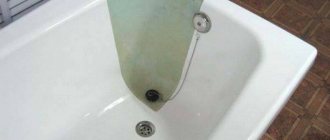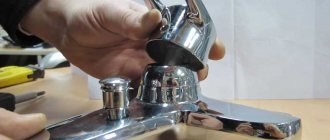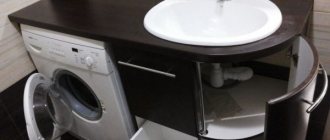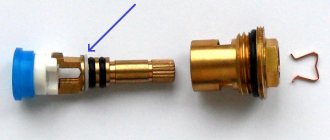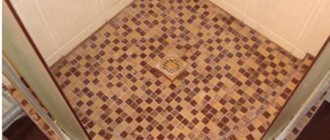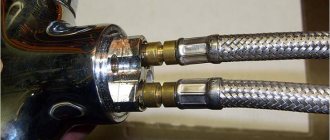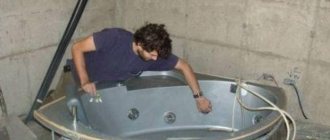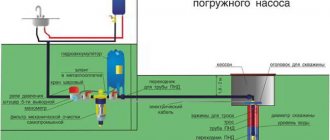The kitchen faucet is the most commonly used plumbing fixture in the home. Therefore, breakdowns cannot be avoided, regardless of its price and quality. The causes of malfunctions are completely different. Sometimes, due to constant exposure to water, the body of the product becomes unusable. The threads in the valve sockets may become worn out and the protective coating may wear off.
To replace a device that has become unusable, it is not necessary to call a plumber. You can easily change the faucet in the kitchen with your own hands if you do everything correctly.
When to replace a kitchen faucet
A mixer is a piece of equipment that can work properly for many years. Faucet breakdowns and malfunctions are the result of many years of exposure to moisture and water impurities on the components of the water supply system and faucet. Here is a list of malfunctions for which replacement of the mixer is necessary:
- Rust has appeared in the area where the faucet and sink meet. Further corrosion of the material will lead to water leakage through the resulting cracks in the sink and the appearance of mold;
- The water does not completely shut off after work is completed. Here the problem lies in the breakdown of the components of the mixer such as the spout, valve or faucet;
- Rust formation at the junction of the spout and the body;
- Problems along the water supply hoses. Often the breakdown is localized at the junction of the hose with the faucet mounting elements, as well as in the area of adapters, if any.
The question “how to change a kitchen faucet” may arise during a renovation, when the selected project requires the installation of a new faucet in the kitchen.
Rust and scale are the first signs of faucet replacement. Metal corrosion processes lead to leaks and disrupt the flow of water
Leaks
How to change a faucet in a sink? The algorithm of actions depends on what kind of breakdown occurred. Let's consider repair options for a leak in a faucet with two valves, as well as from under the flywheel.
- When there is a leak from the gander. Such a breakdown can occur for several reasons. The first includes valve gasket failure due to wear, loss of integrity, deformation, or hardening. For example, integrity failure occurs due to the fact that the gasket is exposed to the sharp edges of the valve seat. The second reason is wear of the valve and seat, which occurs in all mixers with a long service life. So, it occurs as a result of mechanical action of water or corrosion.
- Leakage from under the flywheel. The cause of the failure is the valve gasket or the flywheel rod seal. Poorly sealed flywheel due to the O-ring being loose or deformed. The gasket leaks if it falls off the pin.
As for ball and cartridge faucets, leaks occur when debris or grains of sand get into the valve mechanism. We are talking about the space between the seat and the ball in ball valves. But cartridge faucets begin to leak if debris gets between the shutter disks.
That is, before you look for how to change the faucet in the sink, make sure that this is where the problem lies.
Faucets that are designed for showers can leak for other reasons.
- In the open position, water flows through both the shower and the gander. The cause of this breakdown is the switch. The type of failure depends on the mechanism of the crane itself. This may be a lack of water pressure to switch tightly from shower to spout, or wear of the guide elements in barrel and eccentric switches, or debris getting into the plates and retainers in ball switches, or wear of gaskets in spool devices.
- Leakage directly through the switch button due to damage to the o-ring.
To put it simply, the cause of any leakage or decrease in water flow from any mixers is considered to be clogging of the gander installed at the end of a special device, it is called an aerator. The latter also becomes dirty due to high water hardness, salt deposits that clog the aerator mesh, as well as the opening of the shower head. Scales and salts can cause clogging of the faucets themselves, which also affects the power of the jet. Such malfunctions do not require changing the entire mixer; it is enough to replace some part, and the owner of the apartment himself can handle this.
If fistulas or cracks appear in the valve body, then faulty devices will have to be replaced, even if they are made together with the tap.
By the way, touchless faucets can also break down, become clogged with dirt, the screens can become clogged with salts, and the internal shutter mechanisms wear out. Here you will have to call a specialist for help, and not try to remove the mixer yourself.
Types of kitchen taps
There are 3 main types of faucets that can be seen in the kitchen:
- Two-valve;
- Single lever;
- Contactless.
- Two-valve mixers have been familiar since the times of the USSR. Easy to use, such taps can often be found in the kitchens of most Khrushchev and inexpensive apartments. The operation of a two-valve faucet is based on the operation of a two-piece axle-box faucet for hot and cold water, respectively. When the valve turns, the faucet opens or, conversely, shuts off the flow of water to the faucet spout.
- Single-lever faucets have become popular due to their ease of operation and sleek design. The main difference is the replacement of two axle-box taps with one cartridge with holes that ensure the flow of hot, cold water, as well as mixed water into the spout. With the use of a cartridge, the external structure of the faucet has also changed: now, instead of two valves, one lever is used to regulate the flow of water, which rotates in two planes.
- Touchless faucets are rarely found in residential kitchens.
The peculiarity of the operation of such a tap is to pre-set the water temperature on a special control panel or using an adjustment valve. To turn on the water supply in touchless faucets, simply bring an object to the sensor built into the body. The electromagnetic signal that is generated in this case activates the operation of the solenoid valve, which regulates the water supply to the spout. The tap stops operating a few seconds after the object is removed from the sensor.
Crane axle boxes come in two types: screw and ceramic crane axle boxes. The latter are found in modern models, when screw ones are the lot of USSR times
Cheap single-lever models often use cartridges that incorrectly regulate the supply of hot and cold water. To avoid discomfort when operating such a crane, you should not save when purchasing
The price of touchless faucets is very high due to the additional electronics. Such tap options are often found in cafes, restaurants and other service places
Exotic semi-professional models of cranes
Plumbing fixtures are equipped with a design that can easily be further processed and improved. This is especially true for faucets that are used in the kitchen.
Exotic semi-professional crane model.
Often, buyers seek to replace conventional sink devices with electronic or touch-sensitive ones. From a practical point of view, the installation of models is the same as for traditional ones. But there are certain nuances associated with the electronic control method.
- The need to install powered elements. What are nuts and studs used for?
- Setting temperature conditions, the ability to save them in the device’s memory.
- Adjusting the sensitivity of the sensor.
Touch professional kitchen faucet model.
If there are two sinks in the kitchen, or one, but with separate sinks, buyers can choose to install semi-professional appliances equipped with a high spout, 360-degree swivel, as well as a pull-out shower.
Replacement of appliances at the sink is carried out using a standard scheme. Unless changes in the arrangement of fasteners are possible. Instead of studs, bolts and different holes are sometimes used.
Necessary tools for work
Here is a list of necessary things that you should acquire before starting installation work:
- Adjustable wrench, as well as wrenches in sizes 10, 11, 22 and 24;
- Hoses for connecting the tap to the water supply. Such hoses are sold complete with the mixer, and they can also be found over the counter in a plumbing store;
- Sandpaper for adjusting some elements;
- Screwdriver Set;
- Pliers;
- An electric drill with the necessary bit, if you need to make an inlet hole in the sink for the faucet;
- Kerosene or special lubricant for plumbing. Such compositions are useful in cases of rust accumulation and “sticking” of the faucet to the sink in order to facilitate dismantling.
This simple set of tools should be in every apartment. The only thing is that you will have to buy lubricant or kerasin at a plumbing store
How to change wall-mounted faucets
Sometimes wall-mounted faucet models are included with kitchen sinks. The advantage of this option is the ease of fastening directly to pipes. You do not need to use additional hoses to connect.
Decorative wall-mounted faucet in the kitchen.
Wall-mounted sink faucets are mounted in two main ways. Either with an external location, or with water pipes walled into the wall. But in any case, the replacement will be carried out using the same technology. Places where pipelines are connected and at the same time places where the mixer is rigidly fixed to the pipes. It is due to these connecting parts that the structure becomes especially strong and reliable. It is impossible to remove them.
Material for making faucets and hoses
The mixer can be made from the following materials:
- Metal alloys based on brass, steel or bronze. These mixers have a number of positive properties: wear resistance, long service life, presentable appearance. Of the shortcomings, only one can be highlighted - the high price;
- Plastic. Plastic faucets are inexpensive, have low thermal conductivity and are not susceptible to chemicals. The plastic faucet is very lightweight and resistant to dirt. The disadvantage of such a mixer is its susceptibility to mechanical damage;
- Ceramics are used more for the manufacture of internal parts of the faucet, for example, axle boxes or even a filter. There are completely ceramic faucets, but practice shows their low wear resistance;
- Enameled and chrome-plated faucets are almost no different from those made of metal. Brass and steel are coated with a small layer of enamel or chrome, which gives shine and a metallic color to the product. Beautiful appearance is the main reason for purchasing.
An important property of a plastic mixer is low thermal conductivity. This is relevant in conditions of constant overheating of the tap during a long supply of hot water.
Plumbing hoses also differ in the quality of the material. Among them:
- Bellows hoses. Here the base is a rubber insert, covered on top with a corrugated layer of metal. Such conductors are durable, reliable in operation and easy to install. Low noise insulation is their main drawback;
- Reinforced hoses. They have a rubber gasket that is adjacent to a layer of metal mesh on top. These hoses are easy to bend, resistant to water changes and can be installed without problems. Disadvantages include rapid wear of the fastening nuts and compression of the gasket;
- Stainless steel hoses or nylon hoses. This is probably the most reliable option of all. They are not easy to install, but retain their shape even after the work is completed;
- Aluminum hoses. This option is short-lived, but its components are elastic and pliable;
- Steel hoses. This is a temporary option when installing a mixer, which will soon be replaced by other types of hoses. Steel hoses last no more than one year, and then they leak or completely fail.
They often sell hoses that are too short. Make sure that the hoses you purchase are long enough without tension along their entire length.
It is important that the hose fittings are of different lengths, which will simplify the installation process. The fitting is the end part of the hose that connects to the mixer body
Mixer assembly
At the initial stage of installation work, it is necessary to assemble the kitchen faucet. Its package should include flexible hoses and fasteners (round rubber gasket-ring, washer, rubber seal and 1-2 studs with nuts).
Flexible hoses are screwed into the tap to supply cold and hot water. Particular attention should be paid to the rubber cuffs on the liner fittings, which must not be damaged under any circumstances. It is recommended to moisten them slightly with water before use.
Further assembly of the mixer consists of the following steps:
- mounting pins are screwed into the lower part of the device;
- a rubber sealing ring is installed;
- The hoses are threaded into the holes in the sink.
Instructions for replacing the faucet
Now we have come to the solution to the question: how to replace a faucet in the kitchen. The process can be divided into several stages, which include dismantling the old tap, assembling a new one, installation and connection to the water supply.
Dismantling
What needs to be done before starting work?
- Turn off the water;
- Open the cold and hot water taps to equalize the pressure in the conductive system.
Our advice: remove the sink and faucet. This way the work will be much easier, because the need to crawl into hard-to-reach places will automatically disappear.
To do this you need in advance:
- Disconnect the water supply hoses from the water supply;
- Disconnect the siphon from the sink.
To create a new inlet hole for the faucet in the sink, you will need a drill and a crown of the required diameter. It is important when working not to damage the main part of the sink, preventing the formation of cracks
There may be water left inside the siphon or hoses, which should be drained into a previously prepared container. Now you can start dismantling the sink, and then the faucet itself.
From the back of the sink we begin to disconnect the faucet mount. This may be the first problem - the formation of rust, sticking of the faucet body to the sink. In this case, treat the surface with kerosene or plumbing lubricant, then wait about half an hour and continue working.
In “particularly severe” cases, the use of a grinder will be required. At the same time, try not to damage the water supply connections that are untouched by rust, as well as the sink at the junction with the mixer body
After disconnecting the tap, dismantling ends. Check the condition of the threaded surface of the water supply line to which the new hose is connected. It may be necessary to replace it by installing new extension cords with high-quality threads. Also process the inlet hole in the sink for the new part.
Assembling a new crane
Assembling the mixer consists of connecting the spout to the main body. To do this, using a screwing motion, insert the spout into the corresponding hole in the faucet body until it stops. The connection should be strong, but it is important not to tighten it tightly: this will cause damage in the future.
There are a few more nuances before installing the faucet. For example, check for cracks and other mechanical damage, and also find the hoses for connecting to the water supply, which are included in the kit.
Installation
Faucet fasteners are always included additionally when purchasing, so check their availability. There are two options: mounting with nuts or mounting with studs.
Installing a nut-mounted mixer
The bottom of the faucet should have a cylindrical metal piece whose diameter matches the hole in the sink. It is the basis for fastening. We start with actually attaching the faucet to the sink.
The gasket has the shape of a ring. Make sure that during installation it does not fall out of the cavity, otherwise the tightness of the joint between the sink and the mixer in the area of the inlet will be compromised
- The mixer kit comes with a rubber gasket, which must be inserted into the corresponding slot on the body;
- We insert the cylinder into the mounting hole with the threaded side down, after which we need to gain access to the back of the sink for further measures;
- Next you need to secure the faucet. To do this, we place a rubber plate on the cylindrical part of the faucet, again for tightness, and press it against the lower surface of the sink. We tighten the top with a brass nut, which has a peculiar skirt shape - another solution in favor of tightness;
- Having installed the faucet correctly relative to the sink, we continue the installation by connecting the hoses. You need to start with a short fitting that screws into one of the holes in the cylinder. Then we work in exactly the same way with a hose that has a long fitting.
It is necessary to tighten the nut until the tap is completely immobile. Think in advance about how the mixer will be positioned relative to the sink. If you secure it unsuccessfully, you can always unscrew the nut and turn the tap in the desired direction
Installing a faucet with stud mounting
The difference from the previous installation scheme is the connection of the hoses before attaching the faucet to the sink hole. The fact is that the structural features of the studs will not allow the fittings to be properly fixed when the mixer is already installed.
- First, check the presence of studs in the kit. There may be two of them, or maybe one, depending on the crane model. Also included with each stud is a brass nut of the appropriate diameter;
- Unscrew the nuts and insert the studs into the holes on the underside of the mixer body. You can use screwdrivers, but it will be easier to tighten the studs by hand. Tighten until you feel the fastening is secure without swaying;
- We check for the presence of an o-ring, which is also located in its own notch on the base of the body; We pass the hoses through the hole in the sink, and then attach them to the faucet body. The sequence is the same: first we work with the short fitting, and then with the long one;
- After checking the reliability of fastening, insert the lower part of the part body into the hole in the sink or countertop. On the back of the sink we put on a rubber gasket, on top of which there is a crescent-shaped brass pressure plate. This plate must be included with the tap;
- After applying the metal plate, we tighten the studs using brass nuts, which were previously unscrewed at the beginning of installation.
That's it, installation of the mixer on the studs is complete.
Do not overtighten the hoses at the connection points with the tap and water supply; usually 1-2 turns of the wrench are enough. Otherwise there is a risk of leakage
It is important to check the entire structure for leaks, because When installing the mixer on studs, it is easy to miss the gaps between the rubber and metal plate. The studs may be screwed in at an angle
Connecting to the water supply and checking
We start by returning the sink to its original place with a built-in mixer. To connect the sink to the table surface, it is necessary to treat the edges with sealants, and then press the edges of the metal case tightly. Next, connect the hoses to the water supply. Don't forget that the cold water pipe is usually located on the right, and the hot water pipe on the left.
The final stage of replacing the faucet is connecting the siphon to the sink.
Before supplying water, disconnect the aerator from the spout. Accumulated particles that enter the water supply during installation can clog the small pores of the aerator and lead to its breakdown.
Choosing a good and reliable assistant
A mixer with a high curved gander will allow you to conveniently place large dishes under it.
There are a huge number of mixers on the market today. When you go to any store that sells them, you will see many options for every taste and color - the shape, size, and even functionality may differ. What functionality are we talking about, you ask, the device only mixes cold and hot water! If so, then you don’t know how far human thought has come in creating ease of use of faucets.
We’ll talk about the types of these plumbing fixtures a little later, but now let’s name the main criteria by which they are selected for a specific kitchen.
The cassette mixer is controlled by a lever - it is very convenient to use even with dirty hands
- The first thing people pay attention to is the depth, width and length of the shell (if it is round, then they naturally look at the radius). The mixer should hit the output stream approximately in the center. Moreover, if the sink is shallow, use a low mixer. Illogical, you might say, but no. The fact is that from a jet falling from a height, splashes will constantly scatter to the sides, which will stop the walls of the sink, and since they are low, the space around you is guaranteed to be constantly splashed.
- The second point is the distance from the edge of the sink to the wall. The smaller it is, the more difficult it will be to install large faucet models. This is also affected by the location of the mounting hole. And one more thing - how the water pipes are connected to the tap. There are only two options here - either water will be supplied through flexible hoses from below, or the pipes will come out directly from the walls. Naturally, you will need different types of devices for installation.
- It is also worth considering the number of bowls. The photo below shows the installation on a double sink. Naturally, the mixer should be selected so that it rotates freely, and at the same time it does not unscrew from the base, leaks do not appear, and so on. Also, the size of the gander should be enough to supply water to at least the center of the sinks. In general, the ability to rotate the gander of a faucet installed in a sink is a distinctive feature of kitchen models. Those that are installed on ceramic sinks usually do not have this function.
Installing a faucet on a double sink
Prices for double kitchen sinks
Double sink for kitchen
The most common mixer options today are the following:
Option 1. A classic of the genre is axle-box faucets. They are simple in design, very reliable, and, if necessary, can be repaired if you can find the appropriate repair kit.
Bronze axle-box mixer
The water in such faucets is locked by turning on the faucet - this main part is shown in the photo above. They may differ in their execution. Older versions are full-turn - that is, the faucet handle will have to be turned several times to properly open or shut off the water. Nowadays, half-turn valve axle boxes are very popular - the valve is fully opened after a slight turn of the handle.
Crane axle box
Crane axle boxes can be ceramic or worm. They differ not in materials of manufacture, but in functionality. In the first case, two plates that have holes in certain places for the passage of water rotate around an axis and in a certain position block the passage, that is, these options will be half-turned - if you turn them further than they should be, the hole can open again. Worm mechanisms involve moving a rod that shuts off the water by screwing or unscrewing along a thread - a reversible valve axle box.
Option 2. A popular type of mixers is single-lever. They are loved by users for their ease of control and fairly high reliability.
Interesting to know! Inside this faucet there is a cartridge that mixes the water. This detail largely determines the service life of the product. It can be replaced if a spare part is available. The quality of cartridges will vary significantly from manufacturer to manufacturer.
There are a lot of design options for such faucets - the levers can be installed on top, on the side and even to the side. In general, you will have a good choice.
Find out how to repair a single-handle mixer tap, and also read the device and instructions in a special article on our portal.
Video - How a thermostat mixer works
Single-lever faucets also include ball models, inside of which a special ball with holes is installed to shut off the water. Repairing such models will be difficult due to the lack of availability of spare parts.
Option 3. Rarer and much more expensive faucet models are options with a thermostat. Why are they remarkable? This faucet also has two control knobs, but they are adjusted differently than usual. One of them is responsible only for the water pressure - you make it stronger or weaker, and the second regulates the temperature. It is usually marked in degrees Celsius. By setting, for example, 30 degrees , you get exactly the same temperature at the outlet, and the device itself will regulate the volume of cold and hot water that mixes inside it.
Mixer with thermostat
That is, let's say you're taking a shower. The water temperature is perfect. But then someone opens another tap in the house and the pressure, for example, of hot water drops sharply, and as a result you are already standing under a barely warm stream. This happens with regular faucets, but not with thermostatic ones. This device will immediately reduce the intake of cold water, maintaining the outlet temperature. Such a mixer operates purely mechanically; if you are interested in learning more about this, watch the video at the end of the article.
Option 4. Last on our list is the option of an electronically controlled faucet. This device is innovative and, naturally, very expensive. It fits perfectly with modern interior styles, such as high-tech.
Electronic mixer
Prices for popular models of electronically controlled faucets
Electronic mixer
Repairing these devices without the necessary knowledge and skills is, of course, impossible, but they have proven themselves to be very reliable. They are controlled by conventional rotating knobs, levers, buttons and touch panels.
Advice! There are options with sensors that turn on when hands or dishes are placed under the mixer. There is no need to use this at home, as it can only bring inconvenience. They are intended primarily for public places where automatic control over water consumption is important.
When choosing a mixer, it is very important to carefully study the method of its fixation. Give preference to massive metal nuts that have a large pressing area. Small ones will constantly get out, and tightening them is much more difficult.
Features of installation work with other types of mixers
Mixer tap with two spouts and filter. A special feature of this faucet is an additional spout for supplying purified drinking water. The installation of the faucet differs only in that it is necessary to connect not two hoses to the base of the body, but three (a water supply from the filter is added).
- Wall-mounted faucets Replacing a wall-mounted faucet is easy. Here you just need to unscrew the nuts that secure the faucet to the wall surface, and then carefully disconnect it from the end section of the water supply. A new mixer is installed along the same path, only in reverse.
- Sensor/Thermostat Faucets These kitchen faucet options are more of a luxury item that you don't see very often. To install or replace a faucet, you need to have an understanding of the electrical conductors that are separately connected to the faucet to provide additional functions: heating water or recognizing objects at a distance. Otherwise, it is better to contact specialists.
Apply the new wall-mounted faucet to the outlet pipes before installation. If the plumbing holes and the parts do not match, use adapters. Usually adapters are included immediately
Preparing to install a new device
First, the faucet itself, purchased in a store, is removed from the packaging for work. If a visual inspection was not carried out earlier, then this must be taken care of now. The main thing is that there are no defects or damage on the surface, even minor ones.
Kitchen faucet with hand sensor.
If the product is defective, then branded stores must accept it and exchange it, at the first request of the buyer. In this case, you only need to take care of keeping the sales receipt. There are the following parameters that deserve separate checking for older products.
- Quality of flexible hoses used for connection and operation.
- The integrity of the thread where one part connects to another.
- Rotation or movement of flow regulators. Otherwise, the installation of the mixer will not proceed correctly.
The movement of the part should be easy and smooth during operation. The model you purchase does not matter. The slightest defects must be excluded at the connecting threads. Otherwise, the risk that the entire assembly will be damaged increases. And the old ones will have to be replaced with new ones.
The nickel plating of the mixer should remain smooth and uniform during operation. Scratches and dents are not acceptable on this product. The protective polished casing must not be damaged.
When purchasing a new faucet, inspect it carefully to ensure there are no cracks.
The internal outlets of the pipes themselves must be thoroughly cleaned before proceeding with the installation of a new product. A rough metal brush will be an excellent help in solving this issue. The place where the faucet is installed on the sink requires additional cleaning. A rag helps in this case. And for old parts too.
Tips and tricks
- Replacing the faucet should be accompanied by installing new hoses and a sink. Complete renewal of parts of the water supply system will increase the service life of the equipment, providing peace of mind for the owners for many years;
- Metal-plastic hoses are an alternative to flexible bellows and reinforced counterparts. The rigidity of the structure and the need to purchase fittings for metal plastic complicate installation, but in the future you will not need to worry about this section of the water supply;
- When dismantling and installing a new faucet, it is not necessary to remove the sink. However, practice shows that working with a fixed sink is inconvenient: you have to spend a long time in unimaginable positions, trying to get to all the nuts and connections;
- When connecting the siphon to the pipe, tighten the nuts without using keys. This way you will definitely not damage the plastic parts;
- Just in case, it’s worth purchasing fum tape or a sealant paste of your choice, because if a leak occurs, they will help create an additional seal and save weak water supply connections.
Replacing the faucet yourself will not be difficult if you follow simple rules and pay attention to some subtleties in the work. There is no need to be afraid of breaking or damaging something, because this will not happen if you have a competent approach and have the slightest idea about installing and replacing a faucet in the kitchen.
Recommendations for choosing flexible hoses
The flexible hoses included in the kit are usually 300 mm long. This may not be enough; moreover, during installation, in order to avoid rapid wear from pressure drops, it is recommended to leave a slight slack in the liner.
In addition, low-quality hoses are found in the set of budget faucets, so sometimes it is advisable to additionally purchase new ones.
When purchasing, you should pay attention to the following points:
- The diameter and type of fastening must correspond to the main pipes.
- Length. If the distance between the attachment points is 520 mm, you need to choose a liner with a length of at least 600 mm.
- The faucet should only be purchased in specialized stores.
- The type of liner varies according to temperature conditions. Accordingly, hoses are marked by weaving red and blue threads into a metal braid. Universal ones are considered more durable.
- You need to pay attention to the quality and thickness of the union nuts. Reputable manufacturers have a nut thickness of at least eight millimeters.
- The fittings must be made of high quality brass. Other materials are acceptable, but usually have a shorter service life.
- The eyeliner should be heavy - light weight indicates low-quality metal.
The smell of the product is also an important criterion. If the chosen eyeliner has a strong odor, this means that technical rubber was used in its manufacture, which can negatively affect health.
Leak test
After turning on the cold water pipes, check the water pressure level and the presence of leaks at the connections. A similar check is carried out when connecting hot water supply. If no leaks are found, then all work was carried out efficiently.
If there is a water leak at the junction with the pipes, you need to tighten the nut a little more (half a turn). If the nut is screwed in at the proper level, but the leak is not eliminated, this may be due to damage to the gasket or the presence of burrs on the thread.
How to connect filters
Using clean water for drinking and cooking is one of the ways to maintain health – for you and your loved ones. Nowadays, it is not difficult to obtain potable water in an apartment. Special filter systems will help cope with this task.
If you have already purchased a water purification kit, you will have noticed that it includes several straws, a mini-faucet and a key. Keep in mind - you will not need any sealing tapes, sealing pastes or threads.
Step-by-step instructions for connecting the filter system
- Turn off the cold water using the tap located under the sink. It is located on the pipe and a cold water supply is connected to it for supply to the mixer. Don’t confuse it with a “hot” tap - open cold water and check if it flows.
- We unscrew the hose and instead mount the tee that came with the kit, and then screw the liner to it. Open the cold water and check the tightness of the joints.
- We decide on the location of the filter installation. It is better to place it on the side wall of the cabinet. We advise you to place it in such a way that the filter that performs rough cleaning is easily accessible - you will change it more often than others. There should be at least 10 cm at the bottom so that replacement can be done without hindrance. Leave a distance of approximately 10 cm from the doors at which it cannot damage the hoses. The kit includes a template that will facilitate the fixation procedure. We screw the screws into the marked points.
- We remove the plugs and connect the tubes to the filter in accordance with the arrows indicating the correct direction in which the water should move in it. First, we insert the tube through which untreated water is supplied from the system and connect it to one of the outlets of the previously installed tee. Then insert the outlet tube into the filter with the side without the metal tip until it stops.
- We connect the faucet for drinking water from the kit or a special mixer with two spouts - one for ordinary water, the second for drinking water. Such a device allows you to avoid making additional holes in the sink or countertop, but it will cost more than the standard version. Another drawback is that if the mixer fails, you will not have a single source of water left.
A separate faucet must first be secured to the sink or work surface, and only after that the filter tube must be attached to it. To install a two-in-one faucet, you need to find out whether the design has an adapter into which you can insert a drinking water supply tube. If there is none, you will have to cut off the metal tip from the tube and put a nut on it. After this, insert the fitting and screw the nut onto the thread.
- Check the tightness of the system and rinse the filter for 4 minutes. The water may contain impurities and white foam.
What to consider before starting installation?
First you need to decide on the installation method: the mixer can be mounted on a countertop, sink body or on a wall. It is necessary to outline in advance the routes for the location of hot and cold water pipes.
In this case, the connection points must be accessible in case of subsequent repairs or maintenance. If you plan to install a filter, then the place for its installation must be provided in advance.
Several recommendations for choosing a mixer
The mixer is invariably operated in tandem with the sink, so when choosing a product you need to take into account its size and depth, as well as:
- distance between the wall and the hole for the mixer;
- diameter of the hole for the mixer insert;
- drain location points.
In this case, the faucet must be of sufficient length so that the end of the spout, after installation, falls on the center of the sink or sink.
The length of the spout should be equal to half the width of the sink bowl. The most ideal case is when a stream of water hits the drain directly
The height of the spout should be enough so that you can place a tall pan under the tap. But don’t go to extremes and buy a faucet that is too tall. Otherwise, splashes are created that fly outside the sink.
Another important parameter regarding the geometry of the mixer is the rotation angle. If the sink is close to the wall, then it is enough to install a faucet with a rotation angle of up to 90 degrees. If you use a sink with two bowls, then you need to pay attention to models with a rotation angle of 180-360 degrees.
Variety of styles of plumbing fixtures
Having finished with the technical part, you need to decide on the appearance. Today, the choice of faucet styles is so huge that even the most spoiled owner will be able to find a model to suit his taste.
Classic, hi-tech, loft, minimalism, chopped and streamlined shapes, chrome, copper or black - you can choose an option for any kitchen.
At the same time, unfortunately, the rule applies: the more expensive, the better - especially true for plumbing fixtures and faucets in particular. There is a limit to everything, but high-quality plumbing fixtures made in Europe are an order of magnitude more expensive than domestically made products.
Determining the optimal design
When choosing, you need to take into account the design features of the mixers. The most practical models are single-lever ones, in which the flow intensity and temperature can be adjusted using one handle. Models with two valves are less practical, but go well with the classic kitchen interior.
A single lever mixer is the most practical option in the kitchen. With one movement of your hand you can adjust both the jet strength and the water temperature
Manufacturers also produce contactless products that are equipped with a motion sensor. When you raise your hands, the sensor is triggered and the mixer starts dispensing water.
For the kitchen, this is also not the most practical option, since you often have to change the temperature and collect water in containers.
Prices for faucets depend on the type of alloy used and the brand of the manufacturer. The cheapest models are made of silumin, have a beautiful appearance, but quickly wear out and become unusable. Silumin and other cheap alloys crumble and crack quite quickly.
The highest quality products are made from brass. A layer of nickel, aluminum or chrome is applied to the surface to give the faucet a beautiful appearance. Chrome plated products are the most wear-resistant. We recommend that you read our other article, in which we described in detail the features of choosing kitchen faucets.
Image gallery
Photo from
Kitchen valve mixer
Vintage style faucet model
Single lever kitchen faucet
Operating the articulated device
Connection to communications
At the final stage, the kitchen faucet is connected and connected to the plumbing system. The liner nuts are screwed onto the threads on the pipes. Moreover, it is not necessary to wind with FUM tape. The nuts have a flat rubber gasket that perfectly seals the connection.
The nuts are screwed in first by hand and then with a wrench. It is not recommended to tighten them too much.
After this procedure, the plumbing fixture should be opened and connected to a cold water riser.
Mounting the device on a wall
Installing a faucet into the wall is a rather original solution for the kitchen interior. In this case, the crane will occupy a minimum of working space. Appropriate cutouts are first made in the tile or wall through which the connection will be made.
This type of installation looks quite aesthetically pleasing. In some cases, the pipes from the wall are brought outside, but this option is detrimental to the interior of the kitchen; it is better to hide all the pipes behind the wall.
Wall mounting does not require the use of flexible hoses. The main difficulty is to remove the pipes and cover them behind a layer of finishing
Installing the mixer on the wall requires appropriate water supply with the elements for connection to the outside. The connection method is the same for iron, plastic, copper or metal-plastic pipes, with the exception of the use of adapters and fittings.
The connection method is also not affected by the type of mixer (valve, cartridges, etc.). A prerequisite is the selection of a wall-mounted mixer, the design of which involves installation in the wall.
For installation on iron pipes, tees and angles are used. If the axes of the connectors for connecting the mixer coincide with the axes of the pipes, then it is enough to use couplings. To connect to other types of pipes, special fittings are used, which are also called water sockets.
Features of wall-mounted mixers
These models can be mounted at any height. Faucets are available with flexible and rigid spouts. Flexible ones have many position variations that allow you to perform any task in the kitchen. Products with a rigid spout require limited travel and rotation of the mixer.
The design of wall-mounted faucets is varied, as are their external design features. The photo shows a chrome-plated device with a flexible spout and aerator
For most kitchens, wall-mounted models are a fairly convenient and practical solution.
Connection sequence
First you need to screw on the eccentrics that connect the mixer to the pipes. To avoid increased condensation formation, the distance between the pipe axes should be 150 mm.
Most wall mixers are produced with exactly this distance between the eccentrics. You need to wrap tow (linen or synthetic) around the threads.
Threaded connections wrapped in tow or linen thread and then treated with sealant last longer and do not allow water to pass through
Next, screw the faucet nuts onto the eccentrics and install the decorative screen (overlay). It is carefully screwed on by hand, as it must fit snugly to the surface of the wall.
If the gap is no more than 5 mm, then you can disconnect the mixer and cut the eccentrics to the appropriate length. The decorative panel hides all imperfections on the wall.
Next, you should install the gaskets, which are included with the mixer and can be made of silicone, paronite, rubber and other polymer materials.
Gaskets are inserted into the housing nuts, ensuring a tight fit to the eccentrics. For maximum density, there should be no cracks on the eccentric. An uneven cut surface can be sanded with sandpaper.
The last stage is tightening the nuts: first with your hands, and when your own efforts are no longer enough, you need to tighten the connections with an adjustable wrench. The efforts should not be excessive so as not to damage the threads.
Installing a faucet into a countertop
For this method, in addition to the devices described above, you will need the following:
- electric jigsaw;
- drill;
- set of drills.
The installation method is practically no different from the previous one. Only in this case there is no need to dismantle the sink. Installing a faucet into a countertop requires making a hole in the countertop itself.
To install it in the countertop, you need to make a hole of suitable size. Externally, it should look like a similar hole in sinks
The choice of location for the hole should be based on practical recommendations:
- water should not fall on the countertop while using the mixer;
- the valves/lever should be comfortable to use;
- The spout should be positioned relative to the sink according to the recommendations presented at the beginning of the article.
First you need to make markings along the contour of the base of the mixer using a pencil. Using a drill, drill four holes in the corners of the drawn perimeter.
Then use a jigsaw to cut a hole through which you can pull the liner and insert the threaded pins. The cut needs to be cleared of sawdust and the edges cleaned with sandpaper.
It is important not to make the hole too large. Otherwise, the size of the clamping ring may not be enough to cover the entire hole. Further, the sequence of actions remains the same as when installing the mixer on the sink.


